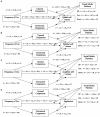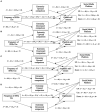The associations between social comparison on social media and young adults' mental health
- PMID: 40861344
- PMCID: PMC12370522
- DOI: 10.3389/fpsyg.2025.1597241
The associations between social comparison on social media and young adults' mental health
Abstract
Introduction: Social networking sites (SNSs) have become an integral part of daily life, raising concerns about their potential impact on mental health. One key mechanism through which SNSs may affect wellbeing is social comparison. The present research aimed to examine the mediating role of social comparisons (upward and downward) in the relationship between SNSs use and self-esteem (global and physical).
Methods: Study 1 (N = 139; female 51%; 73% White), conducted during the COVID-19 pandemic, tested whether perceived exposure to social comparisons mediated the relationship between Instagram use and self-esteem.
Results: Results revealed that upward comparisons mediated the association between Instagram use and lower global self-esteem, but no significant mediation was found for physical self-esteem. Study 2 (N = 413; 58% female; 62% White), conducted post-pandemic, extended these findings by including two SNSs (Instagram and Facebook), the extremity of upward comparisons (how far superior the comparison target is perceived to be), social feedback (responses or evaluations from others) and measures of depressive symptoms. As expected, exposure to upward comparisons negatively mediated the relationship between SNSs use and self-esteem (both global and physical), and positively mediated the relationship between SNSs use and depressive symptoms. However, contrary to our hypothesis, frequent SNSs users engaged in less extreme upward comparisons, partially buffering the negative impact of extreme upward comparisons.
Discussion: Together, these findings highlight the crucial role of both exposure to and extremity of upward social comparisons in the complex relationship between SNSs use and mental health. These two factors contribute significantly though modestly to the effects of SNSs on self-esteem and depressive symptoms (R 2 between 6 and 9%), underscoring the need for further research on individual and contextual variables that may mitigate their adverse psychological consequences.
Keywords: depression; mental health; psychology; self-esteem; social media; social psychology.
Copyright © 2025 Le Blanc-Brillon, Fortin, Lafrance and Hétu.
Conflict of interest statement
The authors declare that the research was conducted in the absence of any commercial or financial relationships that could be construed as a potential conflict of interest.
Figures







References
-
- Ahn J., Yang Y. (2023). Relationship between self-esteem and risky sexual behavior among adolescents and young adults: a systematic review. Am. J. Sexual. Educ. 18, 484–503. doi: 10.1080/15546128.2022.2118199 - DOI
-
- Akkaş C., Turan A. H. (2024). Social network use and life satisfaction: a systematic review. Ment. Health Soc. Incl. 28, 231–251. doi: 10.1108/MHSI-03-2023-0037 - DOI
LinkOut - more resources
Full Text Sources
Research Materials

